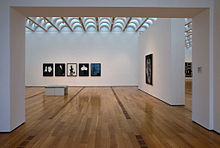[contextly_auto_sidebar]
 Over the weekend I made my first visit to Atlanta’s High Museum of Art. I didn’t have time to check out the entire museum, and I missed an exhibit dedicated to the Hapsburg Empire. But I did see most of what the place – a 1983 Richard Meier building with a 2005 Renzo Piano expansion – has to offer.
Over the weekend I made my first visit to Atlanta’s High Museum of Art. I didn’t have time to check out the entire museum, and I missed an exhibit dedicated to the Hapsburg Empire. But I did see most of what the place – a 1983 Richard Meier building with a 2005 Renzo Piano expansion – has to offer.
I spent the majority of my time on the skylight level, which includes most of the modern and contemporary work. Compared to the museums in New York and Los Angeles that I know better, the canonical American modernism is a bit thin: I kept waiting to round a corner and see a major Pollock or a large Rothko. But this is a handsome, well-lit space that includes a lot of strong work: This part of the collection succeeds on its own terms.
The first room – “The Modern Age: Early Twentieth-Century American Art” – mixes paintings with sculpture and design. These galleries are intimate and set the work off in good proportion. The painting ranges in quality, but some of the design – Paul Frankl’s Viennese-style bookcase from 1926, K.E.M. Weber’s chrome-plated armchair from 1934 – were striking.
In the Postwar World, the familiar American titans – Guston, Albers, Bearden, Arbus — show up, as do a Noguchi coffee table and two small Rothko paintings.
The galleries get larger as you push toward art of the present. There is an enormous Laura Owens piece, an Alex Katz oil (“Meadow”) nothing at all like his figurative stuff, Anselm Kiefer’s “Dragon.” There are also galleries with several pieces each by Ellsworth Kelly, Gerhard Richter, and Radcliffe Bailey, who makes partially abstract mixed-media pieces that explore elements of black history.
There was also a small show of Brett Weston’s crisp black-and-white photography. The very earliest pieces were a bit too close to his father Edward’s work. But his urban and architectural work was more distinctive; I was glad to get a sense of his career.
The collection of self-taught and folk-artists, which included a gallery dedicated to the Rev. Howard Finster, was quite fine. (I”ll try to write about it more completely after another visit.)
The exhibit of work by children’s book author Mo Willems was a minor disappointment. Most of the pieces are quite close to what’s already in his books. This said, the exhibit space was well-designed, and my 9-year-old son, who learned to read partly from Willems’ books, enjoyed it.
One of the museum’s highlights is “Analog Digital Clock,” a piece by the Dutch artist Maarten Baas. I won’t spoil the piece’s surprise by explaining it here. But it’s one of the most inventive pieces of contemporary art I’ve seen in the last few years.
Over all, the permanent collection seems to be in good shape, though few of the recent traveling shows have inspired me to make the trek. The museum recently got a new director, Randall Suffolk; I’ll be curious where he takes the place.

I think that if the High family had not donated their home and land on Peachtree Street to built a museum there would not be such a large museum of art in Atlanta. I am also surprised when I read that the greater Atlanta area has more than 6 million inhabitants and realize that there is only one good art museum in town. For example the whole country of Norway has just a bit over 5 million people and many museums – but after having been here decades I don’t know many people from Marietta, GA who drove the 25 miles to visit the High museum and it is a shame. As you describe there are some good exhibits there. I think the people here prefer sports or shopping malls.